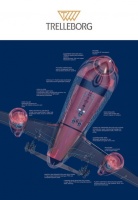
Thanks to material advances pioneered in the offshore industry, glass is increasingly being used in a variety of demanding applications.
Talking to The Engineer, William Ricci, technical sales director with Trelleborg Offshore, explained how materials originally developed as buoyancy foams — based on tiny glass bubbles known as glass microspheres — are proving desirable in sectors including aerospace and automotive.
Ranging from 10 to 100 microns in diameter, these high-grade microspheres (HGMs) are lightweight, strong and exhibit attractive chemical and electrical properties.
Ricci explained that, by incorporating HGMs into a range of polymer and resin systems, it’s possible to create mouldable and machinable syntactic materials (composite materials containing hollow particles) that are ideal for structural or load-bearing applications. ’It can replace or combine with other materials, such as syntactic tooling board, metals and solid polymers, to create composites — and the mechanical strength can be tailored to meet individual requirements,’ he said. There are three key steps to the manufacturing process, explained Ricci.
You start off by manufacturing a glass fret — a high-density particle that contains all the chemistry you want in your final product. You then put it through a heat-treatment process that softens the glass and decomposes a blowing agent, which expands the glass into a bubble.’ Finally, the glass bubbles are chemically washed.
Ricci said that each of these steps can be manipulated in order to fine tune the properties of the microspheres for specific applications and customer requirements. Physical specifications — such as density, collapse pressure and particle size — can all be adjusted to meet specific requirements, while a range of surface treatments can also be employed to, for instance, enhance the material’s bonding properties.
While microspheres are particularly suited for aerospace filling applications — such as in syntactic-foam fan-blade cores or combined with honeycomb materials — Ricci said that the material’s interesting electrical properties — particularly its low dielectric constant and high electrical insulation values — enable it to be used where transparency to radar waves is important — for instance on radomes or lightweight antenna coverings.

For example, commercial aircraft have a forward-looking radar whose field of view must be unaffected by distortions from metal structural elements. Radar transparency, combined with requirements such as lightweightness, structural strength and thermal insulation, leads to the selection of multifunctional materials such as HGMs.
Ricci added that the low dielectric constant/dissipation factor of HGMs makes them suitable as an additive to electronic encapsulation (potting) compounds. The syntactic-foam structure offers long-term thermal protection and electrical insulation, while also protecting against extremes of temperature and vibration.
Microsphere-based polymers also exhibit useful vibration-damping properties that recommends them for use in acoustic-dampening applications. ’Precise pore-size control and volumetric content enable tuning of materials to mask and attenuate unwanted vibrations, modulate speeds of sound propagation and provide directional guidance while still maintaining high strength versus the common-placed ultralow density blown polyurethane foam acoustic insulations,’ said Ricci.
He added that, despite the tiny dimensions of microspheres, they are never smaller than 10 microns in any one direction. This means that when the material is recycled at the end of its life, it doesn’t pose a risk if inhaled .
’Glass microspheres represent a wealth of opportunities in a wide range of sectors. The ability to engineer lightweight structural solutions with very specific requirements, using materials that would not normally be associated with such properties, is very exciting indeed.




Glasgow trial explores AR cues for autonomous road safety
They've ploughed into a few vulnerable road users in the past. Making that less likely will make it spectacularly easy to stop the traffic for...